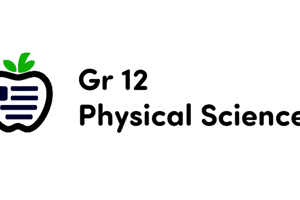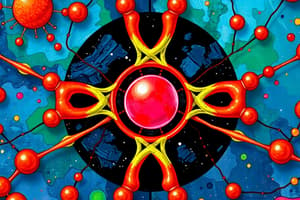Podcast
Questions and Answers
Also known as ______ bonds, interatomic bonds are formed between atoms in a molecule.
Also known as ______ bonds, interatomic bonds are formed between atoms in a molecule.
chemical
[Blank] bonds are typically formed between a metal and a nonmetal.
[Blank] bonds are typically formed between a metal and a nonmetal.
Ionic
[Blank] bonds are formed by the sharing of electrons between atoms.
[Blank] bonds are formed by the sharing of electrons between atoms.
Covalent
[Blank] bonds are formed by the delocalization of electrons in a metal lattice.
[Blank] bonds are formed by the delocalization of electrons in a metal lattice.
[Blank] bonds are formed between molecules.
[Blank] bonds are formed between molecules.
[Blank] bonds are a type of dipole-dipole force.
[Blank] bonds are a type of dipole-dipole force.
[Blank] forces are formed between two polar molecules.
[Blank] forces are formed between two polar molecules.
[Blank] forces are also known as van der Waals forces.
[Blank] forces are also known as van der Waals forces.
[Blank] bonds are stronger than intermolecular bonds.
[Blank] bonds are stronger than intermolecular bonds.
[Blank] bonds hold molecules together in a substance.
[Blank] bonds hold molecules together in a substance.
Study Notes
Interatomic Bonds
- Also known as chemical bonds
- Formed between atoms in a molecule
- Hold atoms together in a molecule
Types of Interatomic Bonds:
- Ionic Bond:
- Formed by the transfer of electrons between atoms
- Typically between a metal and a nonmetal
- Results in the formation of ions with opposite charges
- Covalent Bond:
- Formed by the sharing of electrons between atoms
- Typically between two nonmetals
- Can be polar or nonpolar
- Metallic Bond:
- Formed by the delocalization of electrons in a metal lattice
- Typically found in metals
- Results in a "sea of electrons" surrounding the metal atoms
Intermolecular Bonds
- Also known as van der Waals bonds
- Formed between molecules
- Hold molecules together in a substance
Types of Intermolecular Bonds:
- Hydrogen Bond:
- A type of dipole-dipole force
- Formed between a hydrogen atom bonded to a highly electronegative atom (F, O, N) and another electronegative atom
- Relatively strong compared to other intermolecular bonds
- Dipole-Dipole Force:
- Formed between two polar molecules
- Results from the attraction between the positive and negative ends of the dipoles
- London Dispersion Force:
- Also known as van der Waals force
- Formed between two nonpolar molecules
- Results from the temporary dipoles that form in the molecules
- Ion-Dipole Force:
- Formed between an ion and a polar molecule
- Results from the attraction between the ion and the dipole
Comparison of Interatomic and Intermolecular Bonds
- Interatomic bonds are stronger than intermolecular bonds
- Interatomic bonds hold atoms together in a molecule, while intermolecular bonds hold molecules together in a substance
- Interatomic bonds are typically measured in units of kJ/mol, while intermolecular bonds are typically measured in units of J/mol
Interatomic Bonds
- Chemical bonds formed between atoms in a molecule, holding them together
- Formed by transfer or sharing of electrons between atoms
Types of Interatomic Bonds
- Ionic Bond:
- Formed by electron transfer between atoms, typically between metal and nonmetal
- Results in ions with opposite charges
- Covalent Bond:
- Formed by electron sharing between atoms, typically between two nonmetals
- Can be polar or nonpolar
- Metallic Bond:
- Formed by electron delocalization in a metal lattice, typically found in metals
- Results in a "sea of electrons" surrounding metal atoms
Intermolecular Bonds
- Also known as van der Waals bonds, formed between molecules, holding them together in a substance
- Weaker than interatomic bonds
Types of Intermolecular Bonds
- Hydrogen Bond:
- A type of dipole-dipole force, formed between hydrogen atom bonded to a highly electronegative atom and another electronegative atom
- Relatively strong compared to other intermolecular bonds
- Dipole-Dipole Force:
- Formed between two polar molecules, resulting from attraction between positive and negative ends of dipoles
- London Dispersion Force:
- Also known as van der Waals force, formed between two nonpolar molecules
- Results from temporary dipoles that form in the molecules
- Ion-Dipole Force:
- Formed between an ion and a polar molecule, resulting from attraction between ion and dipole
Comparison of Interatomic and Intermolecular Bonds
- Interatomic bonds are stronger than intermolecular bonds
- Interatomic bonds hold atoms together in a molecule, while intermolecular bonds hold molecules together in a substance
- Interatomic bonds are typically measured in kJ/mol, while intermolecular bonds are typically measured in J/mol
Studying That Suits You
Use AI to generate personalized quizzes and flashcards to suit your learning preferences.
Description
Learn about the different types of interatomic bonds, including ionic, covalent, and metallic bonds, and how they form between atoms in a molecule.




